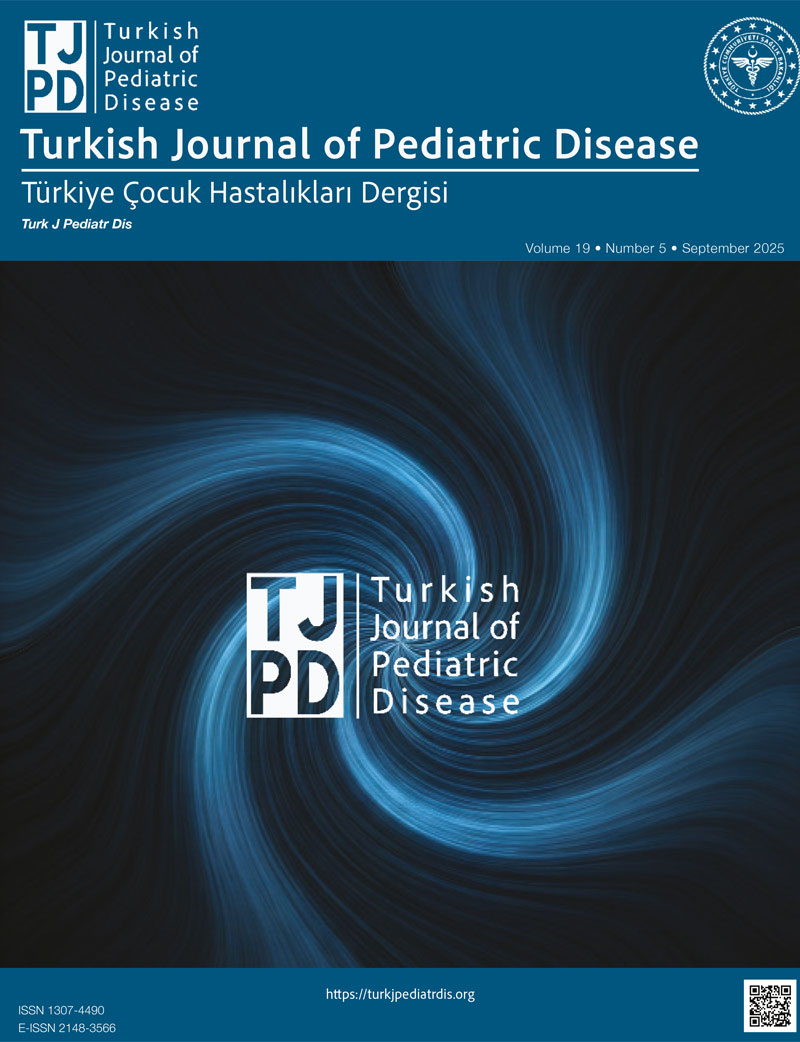Abstract
Objective: Cardiac involvement is a common but often underrecognized feature of inherited metabolic disorders (IMDs), particularly in pediatric populations. Early detection is crucial, since many IMDs have disease-specific treatments that can improve outcomes. This study aimed to evaluate the frequency and spectrum of inherited metabolic disorders among pediatric patients presenting with cardiomyopathy, and to emphasize the importance of early recognition for targeted management.
Material and Methods: We retrospectively analyzed the records of 71 pediatric patients referred to a tertiary metabolic center between 2004 and 2020 due to cardiomyopathy or other cardiac findings. Demographic, clinical, and diagnostic data were reviewed, with a focus on final diagnoses and metabolic etiology.
Results: The median age at presentation was 17 months (range, 15 days-17 years). Dilated cardiomyopathy was the most common phenotype (57.7%), followed by hypertrophic (21.1%) and non-compaction cardiomyopathy (15.4%). An inherited metabolic disorder was diagnosed in 12 patients (16.9%), most commonly Pompe disease, carnitine transporter deficiency, and very long-chain acyl-CoA dehydrogenase deficiency. Parental consanguinity was present in 50% of diagnosed cases. Despite therapy, four patients died due to cardiac failure.
Conclusion: Inherited metabolic disorders account for a substantial proportion of pediatric cardiomyopathy cases. Early metabolic screening should be considered in all children with cardiomyopathy, especially when suggestive features are present. Prompt diagnosis may allow for timely intervention, genetic counselling, and improved outcomes.
Keywords: Inherited metabolic disorders, cardiomyopathy, pompe disease, fatty acid oxidation defects, mitochondrial disorders
References
- Lloyd DF, Vara R, Mathur S. Cardiac manifestations of inherited metabolic disease in children. Pediatr Int. 2017;59(5):525-9. doi: 10.1111/ped.13272.
- Ferreira CR, Blau N. Clinical and biochemical footprints of inherited metabolic diseases. IV. Metabolic cardiovascular disease. Mol Genet Metab. 2021;132(2):112-8. Epub 20201225. doi: 10.1016/j.ymgme.2020.12.290.
- Doenst T, Nguyen TD, Abel ED. Cardiac metabolism in heart failure: implications beyond ATP production. Circ Res. 2013;113(6):709-24. doi: 10.1161/circresaha.113.300376
- Forte M, Schirone L, Ameri P, Basso C, Catalucci D, Modica J, et al. The role of mitochondrial dynamics in cardiovascular diseases. British journal of pharmacology. 2021;178(10):2060-76. https://doi.org/10.1111/bph.15068
- Kasapkara Cs, Olgac A, Yildiz I, Kasapkara Ha, Kilic M. Retrospective Evaluation of Clinical and Molecular Characteristics of Patients with Fabry Disease Being Followed-Up in Our Clinic. Turkish J Pediatr Dis 2021;15(2):117-22. https://doi.org/10.12956/tchd.820757
- Özbey SZ, Gündüz M, Çetin İİ, Ceylan AC, Kılıç E, Ünal Ö, et al. Heart Diseases in Patients with Organic Acidemia. Turkish J Pediatr Dis. 2024;18(3):153-8. https://doi.org/10.12956/tchd.1311485
- Demir F, Topal E, Bulut F, Erdem S, Kor D, Atmış A, et al. Pediatric Cardiomyopathies from the Landscape of Inherited Metabolic Disorders in Southeastern Turkey. Inn J Pediatr.2024;34(1):e141783.https://doi.org/10.5812/ijp-141783.
- Sacchetto C, Sequeira V, Bertero E, Dudek J, Maack C, Calore M. Metabolic alterations in inherited cardiomyopathies. J. Clin. Med. 2019;8(12):2195. https://doi.org/10.3390/jcm8122195
- McKenna WJ, Judge DP. Epidemiology of the inherited cardiomyopathies. Nature Reviews Cardiology. 2021;18(1):22-36. https://doi.org/10.1038/s41569-020-0428-2
- Colan SD, Lipshultz SE, Lowe AM, Sleeper LA, Messere J, Cox GF, et al. Epidemiology and cause-specific outcome of hypertrophic cardiomyopathy in children: findings from the Pediatric Cardiomyopathy Registry. Circulation. 2007;115(6):773-81. https://doi.org/10.1161/CIRCULATIONAHA.106.621185
- Bonnet D, de Lonlay P, Gautier I, Rustin P, Rötig A, Kachaner J, et al. Efficiency of metabolic screening in childhood cardiomyopathies. Eur Heart J. 1998;19(5):790-3. https://doi.org/10.1053/euhj.1997.0818
- Chan J, Desai AK, Kazi ZB, Corey K, Austin S, Hobson-Webb LD, et al. The emerging phenotype of late-onset Pompe disease: A systematic literature review. Mol Genet Metab. 2017;120(3):163-72. https://doi.org/10.1016/j.ymgme.2016.12.004
- Parenti G, Fecarotta S, Alagia M, Attaianese F, Verde A, Tarallo A, et al. The European reference network for metabolic diseases (MetabERN) clinical pathway recommendations for Pompe disease (acid maltase deficiency, glycogen storage disease type II). Orphanet J Rare Dis. 2024;19(1):408. https://doi.org/10.1186/s13023-024-03373-w
- Özsaydi Aktaşoğlu E, Inci A, Öktem RM, Biberoğlu G, Okur İ, Ezgü FS, et al. Expert opinion on clinical presentation, diagnosis, and treatment of infantile-onset Pompe disease: a Delphi study in Türkiye. Turk J Med Sci. 2025;55(3):585-94. https://doi.org/10.55730/1300-0144.6005
- Basan H, Azak E, Çetin İİ, Kılıç E, Bilginer Gürbüz B, Özbey SZ, et al. A Rare Treatable Cause of Cardiomyopathy: Primary Carnitine Deficiency. Mol Syndromol. 2024;15(2):156-60. https://doi.org/10.1159/000534932
- Kayıkçıoğlu M, Özbay B, Yağmur B, Canda E, Bayraktaroğlu S, Şimşek E, et al. Primary Carnitine Deficiency as a Treatable Cause of Heart Failure in Young Patients. Turk Kardiyol Dern Ars 2022;50(7):535-9. https://doi.org/10.5543/tkda.2022.21319.
- Alaei F, Shakiba M, Saneifard H, Vahidshahi K, Alaei M. Defects in Very Long-Chain Fatty Acid Oxidation Presenting as Different Types of Cardiomyopathy. Case Rep Cardiol. 2022;2022:5529355. https://doi.org/10.1155/2022/5529355
- Al Bandari M, Nagy L, Cruz V, Hewson S, Hossain A, Inbar-Feigenberg M. Management and outcomes of very long-chain acyl-CoA dehydrogenase deficiency (VLCAD deficiency): a retrospective chart review. Int J Neonatal Screen. 2024;10(2):29. https://doi.org/10.3390/ijns10020029
- Bugiani M, Invernizzi F, Alberio S, Briem E, Lamantea E, Carrara F, et al. Clinical and molecular findings in children with complex I deficiency. Biochimica et Biophysica Acta (BBA) - Bioenergetics. 2004;1659(2):136-47. https://doi.org/10.1016/j.bbabio.2004.09.006.
- Popoiu TA, Dudek J, Maack C, Bertero E. Cardiac Involvement in Mitochondrial Disorders. Curr Heart Fail Rep. 2023;20(1):76-87. https://doi.org/10.1007/s11897-023-00592-3
- Meyers DE, Basha HI, Koenig MK. Mitochondrial cardiomyopathy: pathophysiology, diagnosis, and management. Tex Heart Inst J. 2013;40(4):385-94.
Copyright and license
Copyright © 2025 The Author(s). This is an open access article distributed under the Creative Commons Attribution License (CC BY), which permits unrestricted use, distribution, and reproduction in any medium or format, provided the original work is properly cited.






